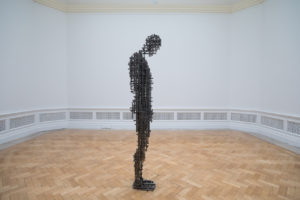
Antony Gormley, Subject II, 2019. 10 mm square section mild steel bar, 189 x 51.5 x 37.5 cm. © the Artist. Photo: David Parry / © Royal Academy of Arts
This exhibition had a profound effect on me – I found it inspirational and am so impressed with this man.
Antony Gormley is described as an internationally renowned sculptor. In my mind he is much more than that. Having visited this exhibition I would describe him also as a visionary, philosopher, architect, and engineer.
The first thing you see on entering the huge courtyard of the Royal Academy is a tiny sculpture of a baby which is in fact a solid iron cast of his six day old daughter.
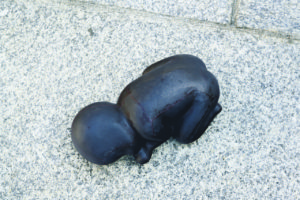
Antony Gormley, Iron Baby, 1999. Cast iron, 12 × 28 × 17 cm. Private collection. © the Artist. Photo: © Oak Taylor-Smith
The human body is at the core of his wide-ranging practice, but he is not interested in realistic likeness. For Gormley, the body is a ‘vessel for feeling’. He sees it as both the unique site of our individual journeys and the one thing we all share.
The first gallery you enter is ‘Slabworks 2019’ with fourteen sculptures distributed across the floor. At first these appear to be building like constructions but then you realise that they are human forms posed in various positions.
I cannot list all of the various exhibits here so will pick out my favourites.
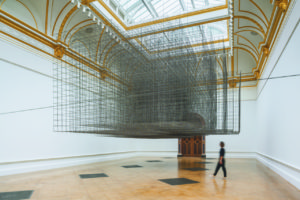
Antony Gormley, Matrix III, 2019. Approximately 6 tonnes of 6 mm mild steel reinforcing mesh, 7.1 x 9.3 x 15.15 m © the Artist. Photo: © Oak Taylor-Smith
Matrix III 2019 is a huge visual labyrinth constructed from steel mesh – commonly used to reinforce concrete walls. Hundreds of thousands of spot welds have been done by hand to join all the sections together. It was designed especially for this gallery with 21 suspended room size cages surrounding a small concentrated chamber. Gormley calls this ‘the space of dreaming’ and is the equivalent to the average size of a European new-build bedroom. As you stand underneath it is difficult to decide what is close or far, in front or behind. I felt tiny standing underneath, as when you look up it seems to go on for infinity. Gormley described Matrix III as ‘the ghost of the environment we’ve all chosen to accept as our primary habitat’.
Subject II 2019 is a single life-size body form, with head bent contemplating the ground on which it stands. Tightly https://everyhealthclub.com/generic-prednisone/ packed vertical and horizontal steel bars map the internal space of the body – what Gormley refers to as ‘the zone of life beneath the skin’.
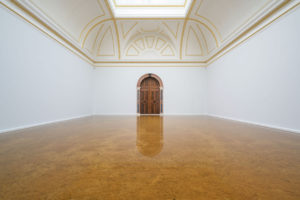
Antony Gormley, Host, 2019. Buckinghamshire clay (51° 44’ 52.5” N 0° 38’ 42.6” W) and Atlantic seawater, dimensions variable. © the Artist. Photo: © Oak Taylor-Smith
Host 2019 – Gormley calls this an ‘invasion of the inside by the outside’. This gallery is in direct opposition to the rigid, hand-manipulated grids of Matrix III. Host consists of basic organic elements (earth, water, air) – Buckinghamshire clay and Atlantic seawater. The work reacts to the atmosphere and changing light, gradually transforming over the days and months of the exhibition.
Gormley asks – is it an image of destruction – a devastating flood? Or of potential creation? Host embodies the raw conditions in which life might emerge, a kind of primordial soup of matter, space and time.
There are a total of 13 galleries in this exhibition and just the way some of the exhibits have been mounted is unfathomable. In one gallery – Body and Fruit – two huge cast iron ‘fruits’ are suspended just inches from the floor by steel cables and when you look up
to the valtrex online domed octagonal ceiling you realise that some of the glass of the dome has had to be removed to feed the cables through. I can only assume that there is a large gantry on the roof to connect them to.
Another fabulous gallery – Lost Horizon I 2008 – features many casts of Gormley’s body which defy gravity. Some are suspended upside down from the glass ceiling by the feet, others protrude horizontally from the wall again by the feet.
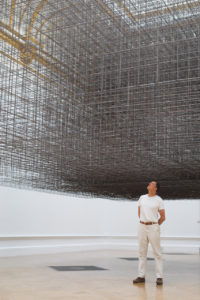
‘Antony Gormley’, Royal Academy of Arts, London, 21st September to 3rd December 2019 © the Artist. Photo: David Parry / © Royal Academy of Arts
Two of the most interesting galleries for me were Drawings I and Drawings II. You start to get into the mind of this creative genius by looking at his drawings and his workbooks.
For Gormley, drawing is a creative wellspring, a meditative daily activity and his drawings are a form of thinking and feeling. Gormley always carries a workbook and the selection on display show his ideas developing over four decades.
To summarise in Gormley’s words:
“I want to use sculpture to throw us back into the world, to provide this place where the magic, the subtlety, the extraordinary nature of our first-hand experience is celebrated, enhanced, made more present”.
Esther Marshall